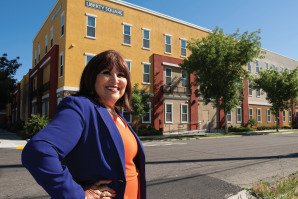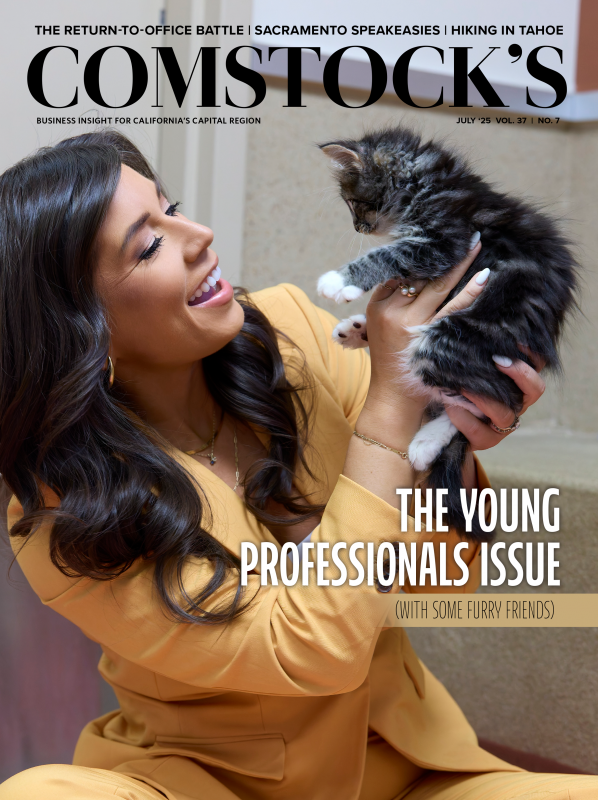Editor’s note: At press time, Gov. Gavin Newsom reached an agreement with the 14,000 members of the Professional Engineers in California Government union that would delay his return to office order for a year. We left their comments in so you can see what their argument was.
Earlier this spring, Gov. Gavin Newsom signed an executive order mandating that most of California’s 224,000 full-time state workers should return to working in the office four days per week starting July 1. For the past several months, most state workers have already had to do in-person work at least two days per week.
Proponents say the impacts on downtown Sacramento, a government town, could be significant as thousands more employees show up to their offices each day. But given the magnitude of the shift, it’s not surprising the executive order has stirred passionate debate, with local businesses in favor of the change and organizations representing state employees adamantly opposed.
Many state workers, already facing a likely postponement of pay raises as part of the governor’s efforts to plug a multi-billion-dollar budget shortfall, are dismayed by the changes. They believe it will cost them in money spent on gas and parking; on travel time wasted stuck in traffic; on the lost $50 per month stipends negotiated for remote workers to cover their home office costs; and in terms of having to go back to crowded offices in Sacramento, many of which have fallen into disrepair in the years since COVID struck.
The Service Employees International Union in Sacramento, one of the most influential of the unions representing government employees, estimates that at the headquarters of the Employment Development Department alone, there is a shortfall of one thousand desks. Unions are also worried about potential outbreaks of illnesses from bacteria that can incubate for years in unused ventilation systems, if offices are reopened quickly and on the cheap.
“It’s very hard for morale and retention,” a Caltrans engineer, who doesn’t want her name used, tells Comstock’s. The workers worry that, when they go back to the office, as often as not they will still be meeting with colleagues around the state via Zoom and other video platforms rather than in person. Given that, they ask why there is urgency to return workers to inflexible in-person schedules.
The Caltrans engineer anticipates having to spend an additional $15 per workday on parking.
“It’ll be a change up to my lifestyle,” she worries, especially given the pay freeze for state employees that the governor imposed in the spring. “It’s disappointing that he’s going ahead with this. It’s a huge change up in the way we were working.”
In his executive order, Newsom frames the issue as being about productivity, the energy generated by in-person interactions in the office and the vibrancy of downtowns — Sacramento’s central city area has been particularly hard hit by the remote work regimen for state workers since March of 2020. “In-person work,” the executive order notes, “promotes collaboration, cohesion, efficiency, and accountability for employees and supervisors, all of which are critical for effectively delivering services to the public and maintaining public confidence in the efficiency of state government.” Others have suggested it’s more a matter of political expediency, with the governor, a likely 2028 presidential hopeful, wanting to neutralize a politically charged issue before campaign season gets underway.
“We’re not going to solve the maladies of downtown Sacramento with a couple thousand more employees
Ted Toppin, Executive Director, Professional Engineers in California Government
there two days a week.”
Newsom’s action, upending a post-COVID norm in which many state workers spent the majority of each workweek at home, was applauded by business groups. Michael Ault, executive director of the Downtown Sacramento Partnership, notes that 60 percent of downtown Sacramento’s office space is either occupied, leased or owned by the state, and without workers in those offices, downtown businesses struggle to stay afloat.
“Downtown is an economic engine for this city and region,” Ault explains. “During COVID it was a ghost town. Downtown runs on energy and activity.” He says it needs the “social collisions” that remote work can never provide. And it also requires, he says, new investments in affordable housing, in conference centers, in hotels, all designed to lure a critical mass of people back into the heart of the city.
“From an urban center standpoint, it’s going to be good to have these workers back,” Ault says. “We want to do something to let the employees know we’ve missed them being here.” To make the transition back to the office easier for workers, the DSP is promoting a host of activities this summer aimed at showcasing the attractiveness of the central city area: a Friday night concert series, “sunset sips” happy hours and other similar community gatherings. It is also investing heavily in safety and security, and partnering with law enforcement and social service providers to “make sure the environment is welcoming for people to come back.”
Workers unions fight back
Unions representing state workers aren’t buying it, and four of them have already filed claims with the California Public Employment Relations Board alleging that Newsom’s executive order is in violation of state law.
“We’re not going to solve the maladies of downtown Sacramento with a couple thousand more employees there two days a week,” Ted Toppin, executive director of the Professional Engineers in California Government, argued. For Toppin and other union leaders, the benefits of a revitalized downtown are more than countered by the higher costs of commuting for their members, by the parking and gas expenses, by the increased pollution that goes with having thousands of additional cars crowd into downtown and by the difficulties around childcare that kick in when state workers with kids suddenly have to follow a rigid in-office schedule once again. They also estimate that it will cost the state millions of dollars to retrofit buildings left either unoccupied or underoccupied for the past five years.
“This is a fight worth having,” Toppin says, in explaining why his organization has been at the forefront of legal efforts to challenge the executive order and maintain remote work options. “For my members, it means some work-life balance and freedom from a long commute. For the state of California, it means lower state costs, eliminating carbon emissions and congestion, and having a smaller footprint. And for taxpayers, if you’re getting happy workers at lower overhead, that certainly serves their purpose.”
Collectively, the unions argue that Newsom’s return-to-office order represents a violation of the 1978 Dills Act, which guarantees California state workers collective bargaining rights. Since remote work has, over the past five years, been embedded into many union contracts with the state, they do not believe it can be undone simply by the governor signing an executive order. Therefore, they are demanding that the governor withdraw the order.
The governor, having staked considerable political capital on this change, isn’t willing to do this — and with the fight escalating, several unions have filed unfair labor practices challenges with the PERB. These challenges, even if some of them are fast tracked, will almost certainly not be resolved prior to July 1, meaning it is a fair bet that workers will have to go back to their offices even while the legal battles are playing out.
For labor advocates, this is an affront. An array of state workers unions, including the SEIU, which represents 35,000 state employees, and PECG, argue that the executive order flies in the face both of research suggesting that workers are at least as productive on remote schedules as they are when mandated to be in their offices, and of collective bargaining agreements in which, for the past five years, remote work has been a core part of labor conditions. Throughout the spring, they filed complaints with PERB, hoping to kickstart a court process that would at least temporarily block the return to office orders.
Anica Walls, president of SEIU Local 1000, argues the governor’s
return-to-office mandate comes without a pay increase for state
workers due to a budget shortfall.

This hardly seems an exercise in efficiency, critics say. In fact, the SEIU notes, during COVID the governor was touting data showing how much money telework was saving the state through lower office expenses and how beneficial it was for state infrastructure.
Anica Walls, president of SEIU Local 1000 — which represents many of the government workers in Sacramento — and an employee at the Department of Social Services Disability Evaluation Analysis, says the return-to-office order ignores collective bargaining agreements painstakingly negotiated between unions and the state.
“He’s essentially cutting our pay and also expecting us to continue providing critical services that California will rely on even more so, given the cuts in federal spending,” Walls says. “It feels like we’re being used as political pawns. … We’re talking about millions of dollars to reopen buildings when it’s unnecessary. We’ve been productive and shown we can save taxpayers in California a ton of money.”
Add all of the pitfalls up, says Walls, and over the summer, as workers return to their offices, “it’s going to be a hot mess.” She anticipates that, if the governor doesn’t bend, state workers will mobilize against the executive order over the coming months, with the 21 bargaining units that negotiate labor conditions with the state holding rallies up and down the state in protest.
Ault sympathizes with state workers but ultimately disagrees with their take on returning to the office. He thinks that with time, they will again come to see the advantages of working downtown, especially if his partnership is effective in making the center of the city more desirable for returning state employees. “We’ve got to have people working together and fostering in-person collaborations,” he says. “But people have gotten used to patterns of working at home.”
Ault stops for a moment to gather his thoughts. “Change,” he finally says, “can be an opportunity.”
–
Stay up to date on business in the Capital Region: Subscribe to the Comstock’s newsletter today.
Recommended For You

Dilemma of the Month: How You Can Help Your Workers Return
How can employers respond to employees’ concerns as they return
to the office or opt not to do so?

Can a State Office Building Become a Home?
To help solve the housing crisis, the State of California has identified excess sites for conversion to affordable housing
In 2019, Gov. Gavin Newsom issued an executive order to identify excess state-owned property that could be converted into affordable housing. Few local examples exist, leaving architects and developers to wonder if they are financially feasible and what, if any, kinds of funding are available.

Going Back Is Hard to Do
How to navigate contentious WFH takebacks
Certainly, many employers are recognizing the business benefits of people working together in an office at least a few days per week, but widespread employee protests have shown that implementing that return is going to be an uphill battle. So what do you do as an employer who’s ready to make that call? And what rights do you have if your boss wants you back in a cubicle?

‘Hushed Hybrid’ Trend May Thwart Return-to-Office Efforts
Companies are changing their work policies, but managers don’t always enforce them
Hushed hybrid is the latest trend that could impede a successful return-to-the-office strategy. What is hushed hybrid (or hushed remote)? It’s when managers overrule, dismiss or choose to not enforce the company’s return-to-office policies.




